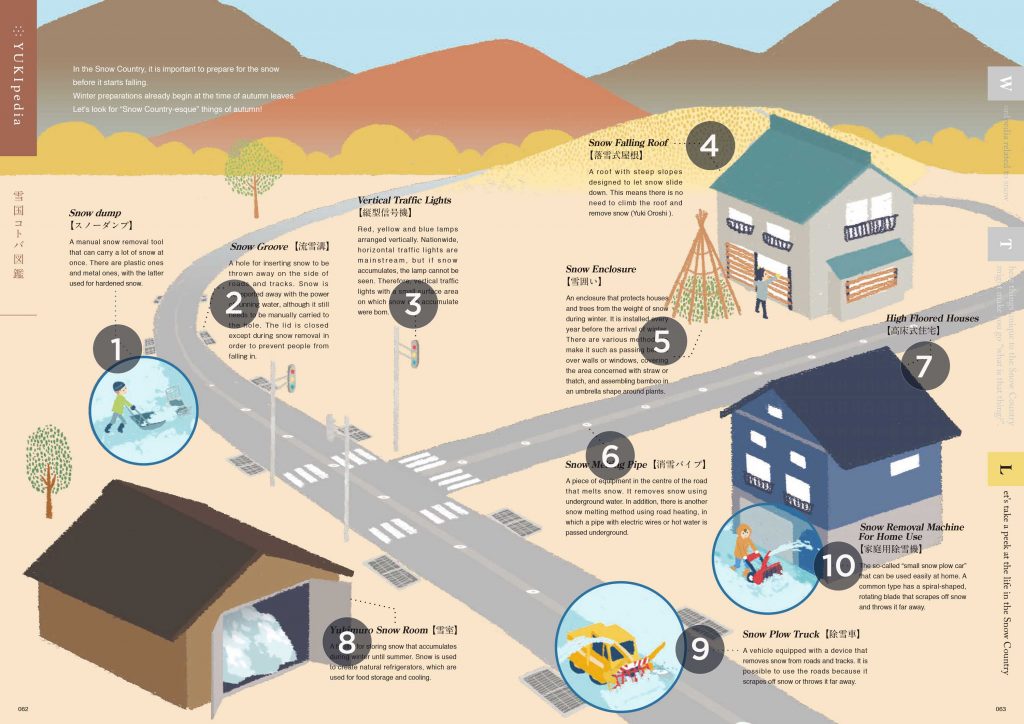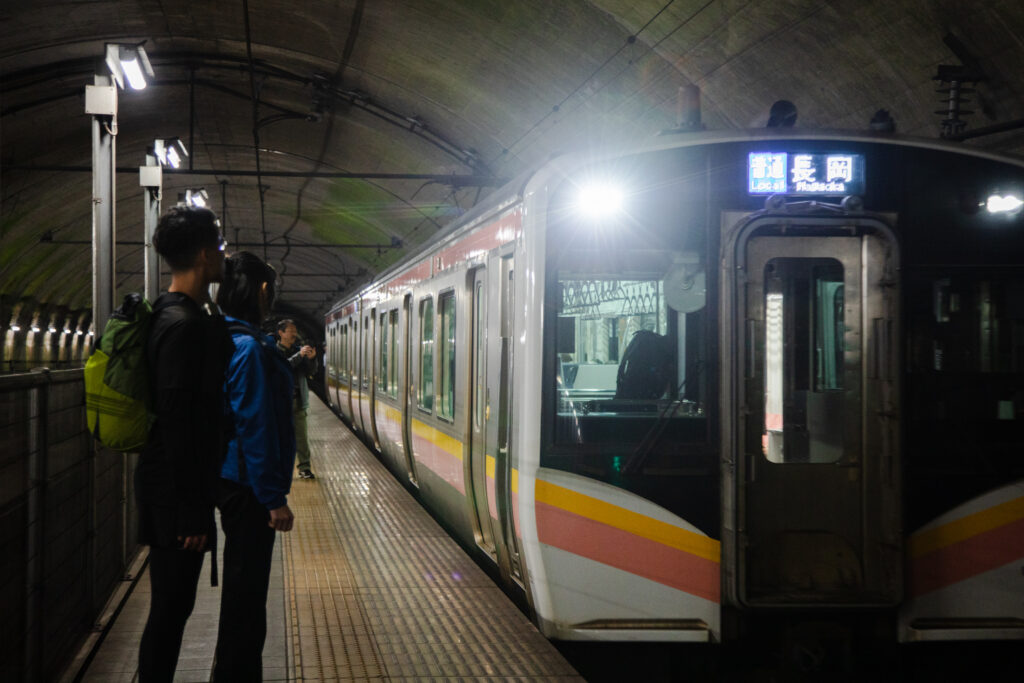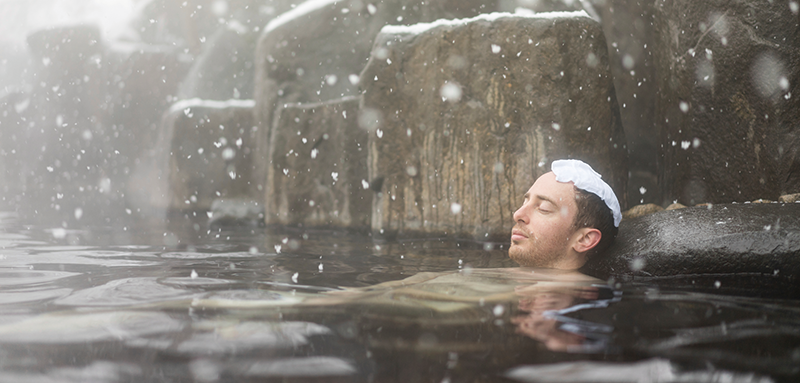There are more than 5,000 languages in the world, but no other language is as developed as Japanese when it comes to onomatopoeia. Onomatopoeia is a French word for mimicry of sounds.
Such expressions include, for example, the sound a river makes when it flows – “sara-sara”(smoothly) in Japanese, the sound of water overflowing (“jabu-jabu” (abundantly)), or a cicada cries (“min-min”). The reason why there are many expressions related to nature may be the influence of the Jomon period during which humans lived in harmony with nature for over 10,000 years.
For an ethnic group, language is a collection of nature, climate, history, and culture that surround this ethnic group. It is natural for us who live in YUKIGUNI to use many words and expressions to express “snow”. These words are summarized as “YUKIGUNI Wordpedia”.
Wordpedia related to snow
Shimiwatari (frozen passing)
In YUKIGUNI, it gets cold in the morning with radiative cooling when spring approaches. Then the accumulated snow gets cold and congeals. It is possible to walk on the snow without getting buried. Because you can walk where you can’t normally walk, children look forward to this period. According to “Tokamachi City History Document 8 Folklore (1995)”, children ran around while singing:
“Shimitakahoi Shiminekahoi Shimitashimita Ho-ihoi”
“Shimitakaho-i Shiminegaho-i”
Dokayuki (huge snow)
A large amount of snow falls at once. Heavy snow is not uncommon in YUKIGUNI where 50 centimeters of snow falls in 2 to 3 hours, and heavy snow piles up for days. Every time it snows, snow piles up without melting. When such a case of “Dokayuki” occurs, railway tracks, roads and building roofs where snow had already been removed, get buried again in snow. In the Hokuriku region, “Dokayuki” often occurs during the period from December to January.
Shinshin
This refers to a state in which snow falls constantly. Unlike rain, snow makes no sound and falls quietly. People express such a state with the word “shinshin”, although snow does not actually make a sound. When it snows “shinshin” on a winter night, you will often see a completely silver world the next morning.
Yuki sarashi (snow bleaching)
“Yuki sarashi” is to unfold a woven cloth on a snowy field and expose it to sunlight. It is an indispensable process in the production of “Echigo jofu”. When snow is melted by the heat of the sunlight, a gas called “ozone” is emitted. This ozone strongly works to bleach the cloth fibers, so the cloth becomes much whiter. “Echigo-jofu” uses particularly thin threads. YUKIGUNI, thanks to the moderate humidity in the air, is a very suitable land for textile production because the threads hardly break.
Hakkoi
It means “cold”. It is considered an accented version of the standard Japanese word “Hiyakkoi” (cold). Use this word when you feel cold from the core of your body. For example, when snow touches your bare back or when snow enters inside your boots. If you get your clothes and skin wet with snow, the skin temperature drops rapidly when the moisture evaporates. This causes frostbite. If you encounter a situation that makes you want to say “hakkoi”, you need to prevent frostbite by wiping your body or changing your clothes.
Zuboru
The state where the foot is buried in snow. If you walk on a snowy road, you will not zuboru as long as you follow the footsteps of other people because the snow will be hardened by their steps. However, if you get your steps wrong, your knees might be buried in snow. In that case, snow may enter inside your boots.
Yukihori (snow digging)
Snow removal is generally called “Yukikaki” (snow shoveling) in standard Japanese. However, in YUKIGUNI, an area of heavy snowfall, we use the word “Yukihori” (snow digging). Here, snow sometimes piles up higher than the roof of your house. In that case, you need to “dig up the house”. The word “Horu” (dig) thus naturally came into use. When the snow on the road is higher than the eaves, dig it to make it lower. When the snow piles up, you remove and throw it away.
Honyara-do
A cave made of snow. In general, it is called “Kamakura” (snow hut) in standard Japanese, but it is called “Honyara-do” in parts of YUKIGUNI. In the Uonuma area, an event called “bird chasing” is held in the New Year’s holiday to protect the fields from birds. The name “Honyara-do” came from the chant used during this event: “Honyara, Honyara, Hoi, Hoi …” Children enjoy making Honyara-do, singing bird chasing songs, and baking “Mochi” (rice cake).
Yukinko
Snow spirit in the form of a child. Nowadays this refers to children of YUKIGUNI who enjoy playing with snow. It is also called “Yuki Doji” (Snow Child) from Niigata folklore. The story begins as follows:
“An elderly couple who are kind lived in YUKIGUNI. Because they did not have children, they made a doll with snow in the form of a child in order not to feel lonely. Then, a child appeared …”
These things unique to the YUKIGUNI might made you go “what is that things?”
Unique sights you can see while visiting the Snow Country. Each natural sight or phenomenon has a name. In the old days, people coined new words for natural phenomena in order to remember and share information about them.If you visit YUKIGUNI and see a mysterious natural phenomenon, you can ask local people for their names. Your own “Wordpedia” may make you a YUKIGUNI expert.
Daikon Tsugura
A storage for storing radishes and carrots in winter. Daikon Tsugura is all handmade. Rice bran is knitted into a cylinder shape. Cover it with a straw lid, and use it as a storage. Even in cold winters, the vegetables Daikon Tsugura do not freeze. It is packed with our ancestors’ wisdom of wintering.
Yukikabe (snow wall)
Snow wall on the side of the road. In YUKIGUNI, when snow accumulates on the road, snow plow trucks carry out snow removal work on a daily basis. Snow is piled up on the side of the road, and the layers of snow accumulate and become like a millefeuille.
Nemagari (root curving)
The base of the tree is bent by the weight of snow. Normally, trees grow straight up. However, the base of trees that grow on the slopes of snowy mountains are weighed down by the weight of snow, so they are bent. Their shape makes them look like they would make for a nice bench. You can see these trees only in YUKIGUNI.
Yukiboshi (snow hat)
Snow in a hemispherical shape piled up on a stone. It can often be seen on riverbed stones, traffic lights, and the heads of Jizo statues (guardian deity stone statues) in YUKIGUNI. The snow in this area contains a lot of moisture, and snow easily packs, making it difficult for it to collapse. Therefore, snow becomes round when piled up.
Yukigata (snow shape)
The shape of snow left on mountain slopes from spring to summer. In a tradition that announces the arrival of spring to YUKIGUNI, when snow begins to melt, residual snow and rocks mix, and the residual snow will show various patterns and shapes. In the past, people used this snow shape as a guide for farming, and to tell the fortune of harvest that year.
Yukimakuri (snow roll)
A natural phenomenon only very occasionally seen on mountain slopes and hills. It is also known as a naturally made snowman. Snow falling from a tree branch or snow rolled up by the wind roll down the slope and forms a shape that looks like a roll cake.
Seppi
Snow that protrudes from roofs. Seppi is formed when lumps of snow on roof slopes slide down slowly. Despite its soft appearance, it is unbelievably hard and heavy. You must not walk underneath Seppi because it is dangerous.
Yukishita Ninjin (snow carrot)
Carrots harvested during fall are preserved under the snow during winter. Yukishita Ninjin, preserved using YUKIGUNI’s unique method, is very sweet and without any bad smell. Inside the snow, appropriate temperature and humidity are kept, making it an ideal environment for carrot ripening. It is no exaggeration to say that this is a masterpiece that makes good use of the natural environment and that combines the wisdom and culture of YUKIGUNI.
Related article: Carrots from Under the Snow
Let’s take a peek at the life in the YUKIGUNI
In YUKIGUNI, it is important to prepare for the snowbefore it starts falling. Winter preparations already begin at the time of autumn leaves. Let’s look for “YUKIGUNI-esque” things of autumn!

1. Snow dump
A manual snow removal tool that can carry a lot of snow at once. There are plastic ones and metal ones, with the latter used for hardened snow.
2. Snow Groove
A hole for inserting snow to be thrown away on the side of roads and tracks. Snow is transported away with the power of running water, although it still needs to be manually carried to the hole. The lid is closed except during snow removal in order to prevent people from falling in.
3. Vertical Traffic Lights
Red, yellow and blue lamps arranged vertically. Nationwide, horizontal traffic lights are mainstream, but if snow accumulates, the lamp cannot be seen. Therefore, vertical traffic lights with a small surface area on which snow can accumulate were born.
4. Snow Falling Roof
A roof with steep slopes designed to let snow slide down. This means there is no need to climb the roof and remove snow (Yuki Oroshi ).
5. Snow Enclosure
An enclosure that protects houses and trees from the weight of snow during winter. It is installed every year before the arrival of winter. There are various methods to make it such as passing beams over walls or windows, covering the area concerned with straw or thatch, and assembling bamboo in an umbrella shape around plants.
6. Snow Melting Pipe
A piece of equipment in the centre of the road that melts snow. It removes snow using underground water. In addition, there is another snow melting method using road heating, in which a pipe with electric wires or hot water is passed underground.
7. High Floored Houses
8. Yukimuro (snow room)
A facility for storing snow that accumulates during winter until summer. Snow is used to create natural refrigerators, which are used for food storage and cooling.
9. Snow Plow Truck
A vehicle equipped with a device that removes snow from roads and tracks. It is possible to use the roads because it scrapes off snow or throws it far away.
10. Snow Removal Machine For Home Use
The so-called “small snow plow car” that can be used easily at home. A common type has a spiral-shaped, rotating blade that scrapes off snow and throws it far away.
YUKIGUNI Trivia
The day after I left my car outdoors, the door would not open.
If you leave the car outdoors in winter, the doors and windows of the car will freeze and cannot be opened. Especially on cloudless sunny days with radiative cooling. When this happens, you boil some water in a kettle on top of an oil stove and pour hot water on the car.
In snowy years, the second floor window becomes the front door
In this region, where there is a lot of snow, in winter, snow falls around the house and snow falls down from the roof, so the house is completely buried in snow. When this happens, the entrance on the 1st floor cannot be used, so the 2nd floor window becomes a temporary entrance.
Why are there many high-floored houses?
When there is heavy snow, 50cm of snow can accumulate overnight. The next morning, it is hard to get to cars completely buried in the snow. Therefore, in YUKIGUNI, the first floor is often used as a parking lot. There are many high-floored houses. This way, we can easily take our luggage in and out, and deal with heavy snow.
In addition, since the residential space is on the second floor, snow that is piled up around the house will not be an obstacle to getting daylight, and winter life will be comfortable. Moreover, a three-story house has the advantage that it can result in a large living space while reducing the land space required.


-1024x626-2.jpg)
